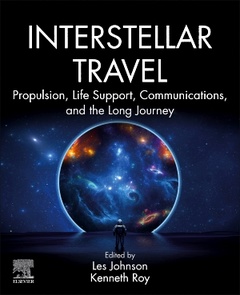Description
Interstellar Travel
Propulsion, Life Support, Communications, and the Long Journey
Language: English
Subjects for Interstellar Travel:
300 p. · 19x23.4 cm · Paperback
Description
/li>Contents
/li>Biography
/li>Comment
/li>
Interstellar Travel: Propulsion, Life Support, Communications, and the Long Journey addresses the technical challenges that must be overcome to make such journeys possible. Leading experts in the fields of space propulsion, power, communication, navigation, crew selection, safety and health provide detailed information about state-of-the-art technologies and approaches for each challenge, along with possible methods based on real science and engineering. This book offers in-depth, up-to-date and realistic technical and scientific considerations in the pursuit of interstellar travel and will be an essential reference for scientists, engineers, researchers and academics working on, or interested in, space development and space technologies. With a renewed interest in space exploration and development evidenced by the rise of the commercial space sector and various governments now planning to send humans back to the moon and to Mars, there is also growing interest in taking the next steps beyond the solar system and to the ultimate destination ? planets circling other stars. With the rapid growth in the number of known exoplanets, people are now asking how we might make journeys to visit them.
2. Propulsion Options
3. Power options
4. The Interstellar environment
5. Crew Health - psychological, biological, medical
6. Life Support
7. Communications and the ability to remain connected to Earth
8. Prospects for Human hibernation
9. Ship culture and government
10. Spare parts and additive manufacturing
11. Optimal crew size at both departure and arrival
12. Artificial Intelligence
His book, Solar Sails, a Novel Approach to Interplanetary Travel was favorably reviewed in the journal Nature (10 April 2008). Graphene: The Superstrong, Superthin, and Superversatile Material That Will Revolutionize the World also appeared in Nature (25 January 2018) and was excerpted in American Scientist (May-June 2018).
Kenneth Roy is a newly retired professional engineer. His professional career involved working for various Department of Energy (DOE) contractors in the fields of Fire Protection and Nuclear Safety. As a long-time research interest, Kenneth has been working with the idea of terraforming. He invented the “Shell Worlds concept as a way to terraform planets and large moons well outside a star’s Goldilocks’ zone and under stars that have a radically different spectrum from our Sun. This was published in the January 2009 Journal of the British Interplanetary Society (JBIS). Kenneth has published multiple papers on terraforming and space colonization that have appeared in leading journals and has written chapters that have appeared in several space related books. Kenneth is a founding member of the non-profit corporation Interstellar Research Group (formerly
- Discusses the technical challenges that must be overcome to mount interstellar missions
- Features various aspects of interstellar travel by the world’s recognized leading experts in the field
- Provides referenceable data and analysis for both new and experienced researchers in the interstellar and deep-space exploration fields




